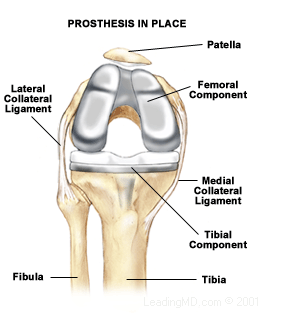Knee Replacement - Recovery

Operative Recovery
The incision must be kept clean and dry for the first two weeks after surgery to allow for healing. Two to three weeks after the operation, sutures or staples are removed during an office visit. During the recovery process, most patients use:
- some form of walking aid such as a walker, crutches, or a cane for six to eight weeks following knee replacement surgery.
- NSAIDS (anti-inflammatory medicines) and water therapy to enhance the results of surgery by maintaining muscle tone and range of motion. Significant physical therapy is added 1-2 days after surgery to strengthen the muscles around the knee and achieve full range of motion.
In some cases, the symptoms of knee arthritis may disappear as early as two to three weeks after surgery, but it may take up to six months to achieve full recovery. Usually throughout this time pain steadily decreases.
The physician will check the patient's range of motion and functional status six to eight weeks after surgery. The prosthesis should be examined annually for loosening or wear.
Complications
Complications that follow knee replacement surgery are rare but can be severe. These include:
- infection of the joint, which usually requires additional surgery and treatment with antibiotics.
- If the wound doesn't heal properly, or the replacement components loosen, an additional surgery will be required.
- Medical complications such as deep venous thrombosis (blood clots) can occur.
- Existing heart, lung, and kidney problems can worsen.
- Fractures around the prosthesis may also require additional surgery.
BackNext